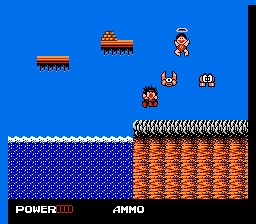Clash at Demonhead
| Clash at Demonhead | |
|---|---|
 North American cover art. Illustration by Lawrence Fletcher | |
| Developer(s) | Vic Tokai |
| Publisher(s) | Vic Tokai |
| Designer(s) | Haruhiko Kawamura |
| Programmer(s) |
Norihiro Hisamatsu Tomiko Narusawa Mayumi Sano |
| Artist(s) | Kazuaki Kinoshita |
| Composer(s) | Michiharu Hasuya |
| Platform(s) | Nintendo Entertainment System |
| Release date(s) |
‹See Tfd› |
| Genre(s) |
Action-adventure Platformer Metroidvania[1] |
| Mode(s) | Single-player |
Clash at Demonhead, known in Japan as Dengeki Big Bang! (電撃ビッグバン Dengeki Biggu Ban), is an action-adventure platformer video game released by Vic Tokai for the Nintendo Entertainment System on January 27, 1989 in Japan and January 1990 in North America. The North American cover was illustrated by Lawrence Fletcher.
Gameplay
Clash at Demonhead is an open-ended platformer in the "Metroidvania" style. The player takes control of Billy "Big Bang" Blitz, who is capable of running, jumping, and shooting. He is initially armed with a handgun, though various upgrades can be purchased from a shop, such as the boomerang gun. He later gains the ability to perform various powers by collecting Force, including shrinking, teleportation to previously-visited areas, flight, healing, and invincibility.[2] The game is divided into a number of smaller stages, each representing a point on the over-world map. There are over 40 routes the player can take in the game, and the player must explore the world to progress. The game is non-linear in that the player can choose which direction he/she goes, being allowed to backtrack and visit different stages.
Plot

Billy "Big Bang" Blitz is a sergeant in S.A.B.R.E. (Special Assault Brigade for Real Emergencies).[3] He is contacted during a vacation at the beach with his girlfriend Mary to save Professor Plum, creator of a Doomsday Bomb capable of destroying the world.[4] Bang soon encounters Tom Guycot, the mastermind behind the abduction, and he learns that the Doomsday Bomb is controlled by six medallions which have been distributed among the seven governors of Demonhead.[5] On his journey, Bang encounters Michael, who claims to be Bang's ally and tells him about a grieving sprite. Upon meeting the sprite, he learns of a captured hermit who teaches Bang various force powers upon rescuing him. While searching for the rest of the medallions, Bang repeatedly experiences strange mental discomfort.
Bang later discovers that the discomfort is a failed attempt at mind control by a demon trapped beneath the mountain at Demonhead's northern end. The demon failed to control Bang, but manages to control Bang's ally, Michael. The demon sets up a plot through Michael to entice Bang with treasure requiring the use of a Magic Stone. The Magic Stone ends up being the key to freeing the demon from its imprisonment. After Bang fails to defeat the demon, it seeks out and kills Tom Guycot and steals his medallion. Bang learns from the hermit that the demon can only be destroyed with the Sword of Apollo.[6]
Upon defeating the demon and recovering Guycot's medallion, Bang attempts to rescue Professor Plum, but learns that the Doomsday Bomb is already complete. The bomb turns out to be technology from an alien race responsible for creating humanity one thousand years ago. They have grown disappointed with their creation's destructive tendencies, and intend to use the bomb to hasten what they believe is the inevitable end of the world. The only way to defuse the bomb is with the medallions, but with no instructions, Bang can only guess where each medallion is placed, and is working against a countdown timer that triggers the bomb. When Bang succeeds, the alien voices its disdain that humanity will live on and announces that the alien race intends to leave Earth to its own devices and never return. Bang responds that from now on humans will look after themselves. Bang escapes Demonhead with the Hermit to reunite with Mary and receives congratulations from his commander, who also informs that Professor Plum managed to free himself and the aliens tried to fool Bang with an impostor. The Hermit offers Bang an apprenticeship, but Bang declines to see about "making a game based on these adventures!"
In popular culture
"The Clash at Demonhead" is the name of a band in the comic book Scott Pilgrim. The band also appears in the 2010 film adaptation, Scott Pilgrim vs. the World,[7] as well as in the subsequent video game adaptation. The band's drummer is named Lynette Guycott, a reference to Tom Guycot and Lynette Gillis (drummer for the indie rock band Plumtree). A character resembling Bang appears in the video game Scott Pilgrim vs. the World: The Game. Clash at Demonhead was the first game that the creator of Scott Pilgrim Bryan Lee O'Malley had ever played.
Reception
Allgame gave the game a score of 2.5 out of 5.[8]
References
- ↑ Fletcher, J.C. (June 7, 2007). "Virtually Overlooked: Clash at Demonhead". Engadget. Retrieved July 11, 2016.
There are a ton of items and upgrades, which actually affect your character's appearance, but can also open up different areas of the game, similar to the method of progression in a Metroidvania game.
- ↑ Clash at Demonhead Instruction Manual. Japan: Vic Tokai. 1989. p. 17.
- ↑ Box art for Clash at Demonhead. Vic Tokai., Ltd. 1989.
- ↑ Clash at Demonhead Instruction Manual. Japan: Vic Tokai. 1989. pp. 4, 5.
- ↑ Vic Tokai. Clash at Demonhead. Nintendo Entertainment System. Vic Tokai. Level/area: Route 1.
Tom Guycot: You haven't got a chance of getting to camp without the royal medaliions of the seven governors.
- ↑ "Clash at Demonhead". Nintendo Power (10). Nintendo of America. Jan–Feb 1990. p. 38.
- ↑ "Scott Pilgrim vs. the World - Movie Production Notes". CinemaReview.com. Retrieved 5 September 2016.
- ↑ Rating for Clash at Demonhead at allgame